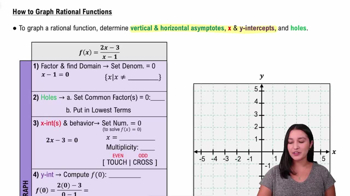Table of contents
- 0. Review of Algebra4h 16m
- 1. Equations & Inequalities3h 18m
- 2. Graphs of Equations43m
- 3. Functions2h 17m
- 4. Polynomial Functions1h 44m
- 5. Rational Functions1h 23m
- 6. Exponential & Logarithmic Functions2h 28m
- 7. Systems of Equations & Matrices4h 6m
- 8. Conic Sections2h 23m
- 9. Sequences, Series, & Induction1h 19m
- 10. Combinatorics & Probability1h 45m
0. Review of Algebra
Exponents
Problem 82c
Textbook Question
Round each decimal to the nearest thousandth. (a) 0.8 (line above 8) (b) 0.4 (line above 4) (c) 0.9762 (d) 0.8645
 Verified step by step guidance
Verified step by step guidance1
Identify the decimal number that needs to be rounded.
Determine the place value to which you need to round. In this case, it's the thousandth place, which is the third digit to the right of the decimal point.
Look at the digit immediately to the right of the thousandth place to decide whether to round up or keep the digit the same.
If the digit to the right is 5 or greater, increase the thousandth place digit by 1. If it's less than 5, keep the thousandth place digit the same.
Apply this rounding rule to each of the given numbers: (a) 0.888..., (b) 0.444..., (c) 0.9762, and (d) 0.8645.
Recommended similar problem, with video answer:
 Verified Solution
Verified SolutionThis video solution was recommended by our tutors as helpful for the problem above
Video duration:
1mPlay a video:
Was this helpful?
Key Concepts
Here are the essential concepts you must grasp in order to answer the question correctly.
Rounding Rules
Rounding is the process of adjusting the digits of a number to make it simpler while keeping its value close to the original. The basic rule is to look at the digit immediately to the right of the place value you are rounding to. If this digit is 5 or greater, you round up; if it is less than 5, you round down.
Recommended video:
Guided course

Cramer's Rule - 2 Equations with 2 Unknowns
Decimal Places
Decimal places refer to the number of digits to the right of the decimal point. In this question, rounding to the nearest thousandth means you focus on the third digit after the decimal. Understanding how to identify and manipulate decimal places is crucial for accurate rounding.
Recommended video:

The Number e
Repeating Decimals
A repeating decimal is a decimal fraction that eventually repeats a digit or a group of digits indefinitely. In the context of this question, the notation with a line above a digit indicates that the digit repeats. Recognizing and handling repeating decimals is important for accurate rounding and representation.
Recommended video:

How to Graph Rational Functions

 7:39m
7:39mWatch next
Master Introduction to Exponent Rules with a bite sized video explanation from Patrick Ford
Start learningRelated Videos
Related Practice













